 Thai Carrot Salad
Thai Carrot Salad Thai Carrot Salad
 Thai Carrot Salad
Thai Carrot Salad 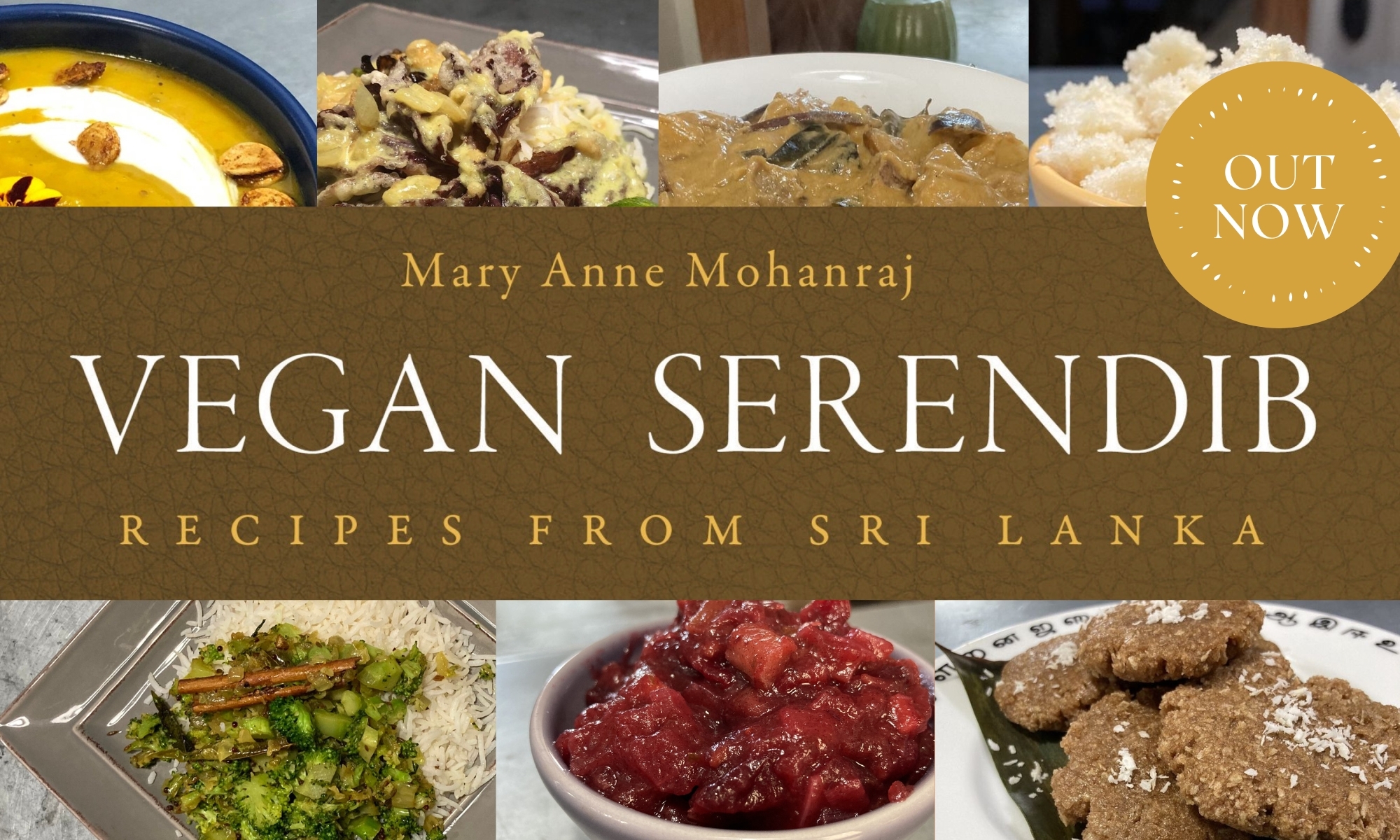
with Mary Anne Mohanraj
 Thai Carrot Salad
Thai Carrot Salad (Lunch today: cauliflower poriyal with a little beef curry on top. Yum. Smells so good when frying the onions in ghee…)
 Cauliflower Poriyal
Cauliflower Poriyal
(25 minutes, serves 4)
The key to this dish is sautéing the cauliflower until it’s browned—the browned bits will be the tastiest. I generally like to serve this dish with beef or pork curry; the slighty salty flavor complements those meats well. This is, oddly, one of my picky children’s favorite dishes, and has often proved popular with my friends’ children as well. I think it’s all the frying.
3 medium onions, chopped coarsely
3 TBL vegetable oil or ghee
1/4 tsp black mustard seed
1/4 tsp cumin seed
1 medium cauliflower, chopped bite-size
1 rounded tsp salt
1 rounded tsp turmeric
1. Sauté onions in oil on high in a large nonstick frying pan with mustard seed and cumin seed, until onions are slightly softened (not brown). Add cauliflower, turmeric, and salt. (I’ve made this in a regular frying pan, and found that it’s difficult not to burn it; if you don’t use non-stick, you’ll need to stir constantly.)

2. Cook on medium-high, stirring frequently, until cauliflower is browned (mostly yellow, but with a fair bit of brown on the flatter parts). This takes a while—don’t stop too early, or it won’t be nearly as tasty. Serve hot.

 This was a fun one for me — an entirely vegan dinner, that I did for last week’s board game night. Pretty easy with Sri Lankan food. Going around clockwise: lentils in coconut milk (tons of protein), carrot in coconut milk, kale sambol, coconut sambol (spicy), seeni sambol (spicy and sweet), eggplant curried in coconut milk, with red rice / quinoa in the center.
This was a fun one for me — an entirely vegan dinner, that I did for last week’s board game night. Pretty easy with Sri Lankan food. Going around clockwise: lentils in coconut milk (tons of protein), carrot in coconut milk, kale sambol, coconut sambol (spicy), seeni sambol (spicy and sweet), eggplant curried in coconut milk, with red rice / quinoa in the center.
If I were doing it again, I’d make more of a bed of red rice / quinoa — I had to go back for seconds on that to happily eat the rest, get the balance right in each bite. And I’d dice the onions for the lentils instead of slicing them — they were a little too noticeable when paired with the sliced onions in the seeni sambol.
This was plenty of food for the number of people we had, but for a larger dinner party, you could expand the plate’s options.
I’d add papadum for crunch, probably some lime-masala mushrooms for the tang. Devilled potatoes would add a luscious spicy-tomato element, though you could also just add tomatoes and potatoes to the eggplant curry for similar effect. Cashew curry or chili cashews would add another hit of protein in rich, nutty form. And while I’ve never had a raita without yogurt, I wonder if you could do something similar with coconut milk, for another cold element.
Proper balance of varied flavors for a Sri Lankan dinner party is an art form! But making it vegan was no more difficult than vegetarian or with meat, it turns out.
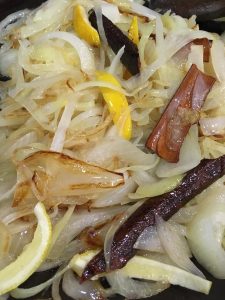 (60 minutes, serves six)
(60 minutes, serves six)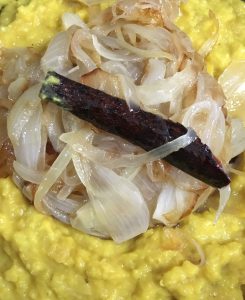
 (20 minutes, serves 4)
(20 minutes, serves 4)
3 medium onions, chopped
3 TBL vegetable oil
1 T ginger, minced
3 cloves garlic, chopped
3 Thai green chilies, chopped fine
1/2 tsp black mustard seed
1/2 tsp cumin seed
six large carrots, sliced into thin coins
1 rounded tsp salt
1 cup coconut milk (can use milk instead, but be extra careful not to curdle)
1. Sauté onions in oil on high with mustard seed, cumin seed, and ginger until onions are golden. Add garlic, carrots and salt. Cook on medium-high, stirring frequently, until carrots are cooked through.
2. Stir in coconut milk and turn heat down to low; simmer until well-blended, stirring constantly. Serve hot.
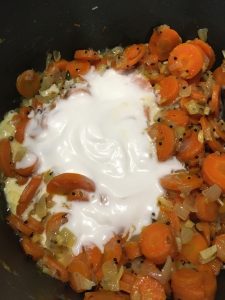
NOTE: You’d typically also add in half a teaspoon of turmeric with the salt, but I honestly forgot this time, and it was still good.
 This may be the most iconic flavor combo of my childhood — beef curry with carrot curry on rice. I think my mom made it close to weekly, and the two flavors go perfectly together — the savory spice of the beef with the sweetness of the carrots cooked in coconut milk.
This may be the most iconic flavor combo of my childhood — beef curry with carrot curry on rice. I think my mom made it close to weekly, and the two flavors go perfectly together — the savory spice of the beef with the sweetness of the carrots cooked in coconut milk.
When I eat it, part of me is twelve years old again, sitting at the kitchen table at dinnertime with my little sisters, reading a book. (I was a terrible conversationalist at family dinner. Mostly still am.)
(Not pictured with actual rice — was trying out shirataki. Shirataki, marketed here as ‘Miracle Rice’ would be an okay substitute for noodles, I think. It basically has no tooth, though, so if I were desperate for no-carb, almost no-calorie, rice-like thing, I might have some, but I definitely like rice + quinoa better for a lower-carb than plain white rice option. Or if I really felt like I wanted a big bed of white ‘something’ to put under curry? I am more than a little weirded out by the almost-no-calorie food concept, though.)
(50 minutes, serves 8)
This accompaniment offers a little extra heat and onion-y zing to a plate of rice and curry.
4 medium leeks
1/4 cup oil
1/2 rounded tsp turmeric
1 1/2 rounded tsp chili powder
1 rounded tsp salt
1. Rinse dirt off outside of leeks. Discard any tough or withered leaves, but do use the green portions as well as the white.
2. With a sharp knife, slice the leeks thinly across the stalk, making thin rings / chiffonade; when you’re slicing the green leaves, make a tight bundle in your hands for easier slicing.
3. Wash the sliced leeks very thoroughly. The soil trapped between the leaves won’t actually taste particularly bad, but the grittiness is unpleasant. I recommend not simply running the sliced leeks under a colander—rather, put them in a large bowl of water and wash them vigorously, changing the water at least three times. This is labor-intensive, but well worth it.
4/ Heat oil in a large saucepan and add the leeks. Sauté, stirring for 5 minutes, then add the remaining ingredients and stir until well blended.
5. Cover and cook over low heat for 30 minutes, stirring occasionally. The leeks will reduce in volume. Uncover and cook, stirring, until liquid evaporates and leeks appear slightly oily. Serve hot.
(1 hr 15 min., serves 4)
1 lb. beets, peeled and cubed into bite-size pieces
2-3 T vegetable oil
1 t. salt
1 t. pepper
1 t. coriander seed
1/2 t. cumin seed
1/2 t. black mustard seed
2 T coconut milk
3-5 minced green chilies
1-2 T lime juice
1. Preheat oven to 350. Toss beets in oil, salt, and pepper, and spread flat on a foil-lined baking sheet. Bake 45 minutes.
2. Add coriander seed, cumin seed, and black mustard seed, and bake an additional 15 minutes, until beets are soft and slightly crispy.
3. Combine coconut milk, green chilies, and lime juice in a large bowl, stirring to blend. Add beets and toss until combined. Season to taste with salt and pepper; serve hot with rice or bread. (Pictured here with beef and potato curry and chili leeks.)
 If I had to pick the perfect Sri Lankan meal, this would be it. There’s nothing like breaking off a crisp piece of hopper, dipping it into broken egg, and scooping up some curry and a bit of seeni sambol. Delectable.
If I had to pick the perfect Sri Lankan meal, this would be it. There’s nothing like breaking off a crisp piece of hopper, dipping it into broken egg, and scooping up some curry and a bit of seeni sambol. Delectable.
These rice flour pancakes have a unique shape; fermented batter is swirled in a special small hemispherical pan, so you end up with a soft, spongy center, and lacey, crispy sides — that contrast is the true glory of the hopper. Typically you’d make one egg hopper per person, plus another plain hopper or two, and maybe a sweet hopper to finish up.

If you don’t have a hopper pan, you can make hoppers in a regular frying pan; you just won’t get quite as much of the crispy sides. It’s a little time-consuming to make hoppers, since each one must be individually steamed for a few minutes, but with practice, you can have four hopper pans going on a stove at once. I’d recommend starting with just one pan at a time, though! Serve with curry and seeni sambol.
2 cups South Asian white or red rice flour (or a mix of rice and wheat flour)
1 tsp sugar
pinch of baking powder
1/2 tsp salt
2 cups coconut milk
eggs for egg hoppers
extra coconut milk and jaggery for sweet hoppers
1. Mix first five ingredients thoroughly in a large bowl, cover, and set in a warm, turned-off oven to ferment overnight. (In a cold climate, fermentation may not occur without a little help—I turn my oven on to 250 degrees, and when it’s reached temperature, turn it off and put the covered bowl in the oven to stay warm.)
2. Mix again, adding water if necessary to make a quite thin, pourable batter.
3. Heat pan (grease if not non-stick) on medium, and when it’s hot, pour about 1/3 cup batter into the center. Pick up the pan immediately and swirl the batter around, coating the cooking surface. The sides of the hopper should end up with holes in them: thin, lacy, and crisp – if the batter is coating the pan more thickly, mix in some hot water to thin it down. Cover and let cook for 2-4 minutes — you’ll know it’s ready when the sides have started to brown and the center is thoroughly cooked. A silicone spatula will help with getting the hopper out of the pan.

4. For egg hoppers, after swirling, crack an egg in the center before covering. The egg will cook as the hopper does, finishing in about 3-4 minutes.


5. For sweet hoppers, after swirling, add a tablespoon of coconut milk and a teaspoon of jaggery to the center of the pan, then cook as usual.
If you don’t use all the batter right away, you can store it in the fridge, but it will keep rising, so make sure there’s some room in your storage container for that, and then you’ll want to thin it back down to pouring consistency with another 1/4 – 1/2 c. of water before use.
NOTE: If you use instant hopper mix, I found that a packet (about 3 cups of mix) used 2 cans of coconut milk plus 2 – 2 1/2 cups of water.

I had never heard of crack seed, but when Jed saw the sign for the Crack Seed Store, he guided me inside, to a wonderland of Chinese snacks.

“Crack seed is a category of snacks that originated in China. It is highly popular in many regions, such as Hawaii. Crack seed are basically preserved fruits that have been cracked or split with the seed or kernel partially exposed as a flavor enhancement. This type of snack is commonly referred to in Chinese language as see mui (西梅; [siː muːi]); it arrived in Hawaii during the 19th century, when Cantonese immigrants were brought to work on the plantations.

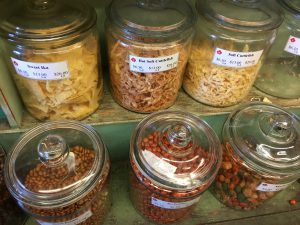
The flavors are varied, ranging from extremely sweet and salty to sour flavors. Flavors can include rock salt plum, honey mango, licorice peach, or any kind of combination of fruits, flavors and type of preservatives used. What originally was a preserved fruit has become a favorite snack in Hawaii and a sample of a cultural food.


Crack seed stores also sell candies such as gummi bears, and Sour Patch Kids, coated with Li Hing Mui powder.
Some types of crack seed found in Hawaii and Asia are dry and chewy types of li hing mui, dried persimmons, preserved mandarin peels, and salted Chinese and Thai olives, also known as nam liap in Thai.” – Wikipedia